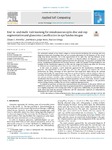Mostrar o rexistro simple do ítem
End-To-End Multi-Task Learning for Simultaneous Optic Disc and Cup Segmentation and Glaucoma Classification in Eye Fundus Images
| dc.contributor.author | Hervella, Álvaro S. | |
| dc.contributor.author | Rouco, J. | |
| dc.contributor.author | Novo Buján, Jorge | |
| dc.contributor.author | Ortega Hortas, Marcos | |
| dc.date.accessioned | 2022-03-23T17:32:43Z | |
| dc.date.available | 2022-03-23T17:32:43Z | |
| dc.date.issued | 2022 | |
| dc.identifier.citation | HERVELLA, Álvaro S., ROUCO, José, NOVO, Jorge and ORTEGA, Marcos, 2022. End-to-end multi-task learning for simultaneous optic disc and cup segmentation and glaucoma classification in eye fundus images. Applied Soft Computing. 1 February 2022. Vol. 116, p. 108347. ISSN 1568-4946. https://doi.org/10.1016/j.asoc.2021.108347. (https://www.sciencedirect.com/science/article/pii/S1568494621011303) | es_ES |
| dc.identifier.issn | 1568-4946 | |
| dc.identifier.uri | http://hdl.handle.net/2183/30193 | |
| dc.description | Financiado para publicación en acceso aberto: Universidade da Coruña/CISUG | es_ES |
| dc.description.abstract | [Abstract] The automated analysis of eye fundus images is crucial towards facilitating the screening and early diagnosis of glaucoma. Nowadays, there are two common alternatives for the diagnosis of this disease using deep neural networks. One is the segmentation of the optic disc and cup followed by the morphological analysis of these structures. The other is to directly address the diagnosis as an image classification task. The segmentation approach presents the advantage of using pixel-level labels with precise morphological information for training. However, while this detailed training feedback is not available for the classification approach, in this case the image-level labels may allow the discovery of additional non-morphological cues that are also relevant for the diagnosis. In this work, we propose a novel multi-task approach for the simultaneous classification of glaucoma and segmentation of the optic disc and cup. This approach can improve the overall performance by taking advantage of both pixel-level and image-level labels during the network training. Additionally, the segmentation maps that are predicted together with the diagnosis allow the extraction of relevant biomarkers such as the cup-to-disc ratio. The proposed methodology presents two relevant technical novelties. First, a network architecture for simultaneous segmentation and classification that increases the number of shared parameters between both tasks. Second, a multi-adaptive optimization strategy that ensures that both tasks contribute similarly to the parameter updates during training, avoiding the use of loss weighting hyperparameters. To validate our proposal, an exhaustive experimentation was performed on the public REFUGE and DRISHTI-GS datasets. The results show that our proposal outperforms comparable multi-task baselines and is highly competitive with existing state-of-the-art approaches. Additionally, the provided ablation study shows that both the network architecture and the optimization approach are independently advantageous for multi-task learning. | es_ES |
| dc.description.sponsorship | This work is supported by Instituto de Salud Carlos III, Government of Spain, and the European Regional Development Fund (ERDF) of the European Union (EU) through the DTS18/00136 research project; Ministerio de Ciencia e Innovación, Government of Spain, through the RTI2018-095894-B-I00 and PID2019-108435RB-I00 research projects; Axencia Galega de Innovación (GAIN), Spain, Xunta de Galicia, through grant ref. IN845D 2020/38; Xunta de Galicia and the European Social Fund (ESF) of the EU through the predoctoral contract ref. ED481A-2017/328; Consellería de Cultura, Educación e Universidade, Xunta de Galicia, Spain, through Grupos de Referencia Competitiva, grant ref. ED431C 2020/24. CITIC, Centro de Investigación de Galicia ref. ED431G 2019/01, receives financial support from Consellería de Cultura, Educación e Universidade, Xunta de Galicia, Spain, through the ERDF (80%) and Secretaría Xeral de Universidades (20%), Spain . Funding for open access charge: Universidade da Coruña/CISUG, Spain. | es_ES |
| dc.description.sponsorship | Xunta de Galicia; IN845D 2020/38 | es_ES |
| dc.description.sponsorship | Xunta de Galicia; ED481A-2017/328 | es_ES |
| dc.description.sponsorship | Xunta de Galicia; ED431C 2020/24 | es_ES |
| dc.description.sponsorship | Xunta de Galicia; ED431G 2019/01 | es_ES |
| dc.language.iso | eng | es_ES |
| dc.publisher | Elsevier | es_ES |
| dc.relation | info:eu-repo/grantAgreement/MICINN/Plan Estatal de Investigación Científica y Técnica y de Innovación 2017-2020/DTS18%2F00136/ES/Plataforma online para prevención y detección precoz de enfermedad vascular mediante análisis automatizado de información e imagen clínica/ | |
| dc.relation | info:eu-repo/grantAgreement/AEI/Plan Estatal de Investigación Científica y Técnica y de Innovación 2017-2020/RTI2018-095894-B-I00/ES/DESARROLLO DE TECNOLOGIAS INTELIGENTES PARA DIAGNOSTICO DE LA DMAE BASADAS EN EL ANALISIS AUTOMATICO DE NUEVAS MODALIDADES HETEROGENEAS DE ADQUISICION DE IMAGEN OFTALMOLOGICA/ | |
| dc.relation | info:eu-repo/grantAgreement/AEI/Plan Estatal de Investigación Científica y Técnica y de Innovación 2017-2020/PID2019-108435RB-I00/ES/CUANTIFICACION Y CARACTERIZACION COMPUTACIONAL DE IMAGEN MULTIMODAL OFTALMOLOGICA: ESTUDIOS EN ESCLEROSIS MULTIPLE/ | |
| dc.relation.uri | https://doi.org/10.1016/j.asoc.2021.108347 | es_ES |
| dc.rights | Atribución-NoComercial-SinDerivadas 4.0 Internacional | es_ES |
| dc.rights.uri | http://creativecommons.org/licenses/by-nc-nd/4.0/ | * |
| dc.subject | Multi-task learning | es_ES |
| dc.subject | Medical imaging | es_ES |
| dc.subject | Glaucoma diagnosis | es_ES |
| dc.subject | Optic disc and cup segmentation | es_ES |
| dc.subject | Cup-to-disc ratio | es_ES |
| dc.subject | Deep learning | es_ES |
| dc.subject | Retinal imaging | es_ES |
| dc.title | End-To-End Multi-Task Learning for Simultaneous Optic Disc and Cup Segmentation and Glaucoma Classification in Eye Fundus Images | es_ES |
| dc.type | info:eu-repo/semantics/article | es_ES |
| dc.rights.access | info:eu-repo/semantics/openAccess | es_ES |
| UDC.journalTitle | Applied Soft Computing | es_ES |
| UDC.volume | 116 | es_ES |
| UDC.startPage | 108347 | es_ES |
| dc.identifier.doi | 10.1016/j.asoc.2021.108347 |
Ficheiros no ítem
Este ítem aparece na(s) seguinte(s) colección(s)
-
GI-M2NICA - Artigos [75]
-
GI-VARPA - Artigos [79]






